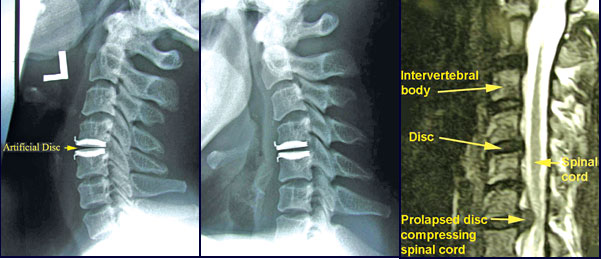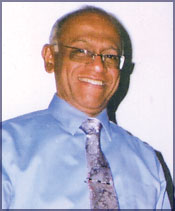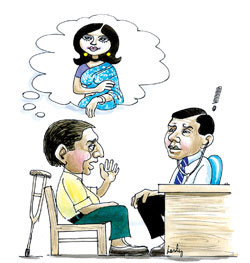|
Health watch |
- Compiled and coordinated by Edward
Arambewala |
Neck pain - Synopsis by Dr James Tan
Introduction
The neck (or cervical spine) performs a very important function of
supporting the head and allowing full motion of the neck; and at the
same time, it must also protect the delicate spinal cord.
Know your neck
Your neck bone consists of seven individual bone (vertebra) with a
soft cushion (disc) between each of them. Every time your nod or shake
your head, these vertebral and disc work together to allow the mobility.
Muscles of your upper back, your shoulders are attached to these neck
bones.
Causes of Neck Pain
There are many structures in the neck that can result in neck ache
and pain. These are the common causes:
1) Wear and tear (Spondylosis) - this refers to the wearing out
(degeneration) of the intervertebral disc that acts as cushions between
the individual neck bones. When the disc wears out, it can no longer
support the neck as well as it used to be. The body tries to repair this
by forming extra bone to act as supports and these are known as bone
spurs (osteophytes). It is these osteophytes that cause compression on
the nerves and spinal cord that result in some of the more severe
symptoms.

2) Disc herniation - when the disc wears out, it can also protrude
outwards and it is this protrusion that results in the sharp arm pain
sometimes experienced by sufferers of acute disc prolapse. This may also
cause tingling in the arms and hands. In more severe cases, there is
even weakness in the upper limbs.
3) Inflammation - this refers to the conditions like rheumatoid
arthritis. This inflammatory process usually affects the fingers as well
as other big joints like the knee joint. In the neck, it usually affects
the upper cervical spine resulting in instability and pain.
4) Postural causes - this is the most common cause of neck pain.
Prolonged postures of the neck in an unnatural position. For example,
falling asleep on the sofa or prolonged working on the computer
(especially on laptops) with the neck bent forward.
5) Traumatic injuries - this can range from minor sprains to severe
injuries as in whiplash injuries in car accidents.
6) Other rare causes like infection, tumours and congenital
abnormalities.
When is it serious?
Most of the time, the pain is self limiting - meaning that it will
reduce over time with simple medications like paracetamol or NSAIDs with
simple stretching exercises. It becomes serious when you have one or
more of the following symptoms:
a) Weakness - this means there is actual nerve compression with
damage to the nerve fibres. If left untreated, paralysis may occur and
be permanent.
b) Numbness or tingling - occasional numbness that goes away after a
short period may be a sign of early nerve compression. If the numbness
is persistent, it means nerve damage has already taken place and muscle
weakness will soon follow.
c) Loss of bladder and bowel control - this is a very serious
situation that warrants immediate admission to hospital and surgery. The
presence of sudden incontinence means severe spinal cord or roots
compression that if left untreated, will result in permanent disability.
d) Persistent pain on neck movement - the pain from neck sprains
usual last from several days to one to two weeks. If the pain persists
in severity and worsens over time, especially if it is associated with a
fall or accident, there may be an undiagnosed neck fracture with
instability.
e) Pain that radiates down the arms - this radicular pain is caused
by the nerve root being squashed (usually due to herniated disc).
Initially, it may just be pain but with time, tingling and weakness will
develop.
What are the treatment options?
The main aim of the doctor would be to exclude serious conditions
that can cause permanent damage.
He will go through the history and performed an examination including
a neurological examination to determine the state of the spinal cord and
nerves.
The next step is imaging studies. There are several alternatives
available:
i) X-rays - This is simple and cheap but yields limited information.
It is most useful to look for presence of fractures and misalignment of
the spine.
ii) CT scans - This is a good tool for looking at bony details but
does not give sufficient information on the disc and spinal cord. This
is usually reserved for those with metallic implants like pacemakers who
cannot have MRIs.
iii) MRI - Usually the investigation of choice as it provides a clear
view of the state of nerve roots and spinal cord.
Treatment is always conservative first before resorting to surgery.
Conservative options include:
- Rest (use of collar for a few days to reduce motion)
- Simple analgesia like paracetamol, NSAIDs or the newer COX2
inhibitors.
- Exercises - stretching and strengthening
- Hot packs
- Modification of lifestyle
- Physiotherapy including traction, mobilisation.
Surgery is sometimes needed when the above methods fail to provide
relief or when there is danger of permanent nerve or spinal cord damage.
Surgical options include:
- Fusion - a procedure where the damaged disc is removed and bone is
inserted between the vertebras to fuse the level. This relieves the
pressure on the nerve and spinal cord but it also increases the stress
to the disc above and below the operated level.
- Arthroplasty
(artificial disc replacement) - this is the newer approach where
after disc removal, an artificial disc is inserted. This performs the
same function as the disc by allowing motion at the operated level and
reduces the damage to the adjacent discs.
- Laminectomy/ Laminoplasty - this is a time tested way to reduce
pressure on the spinal cord over a large area by removing part of the
bone. This surgery is performed from the back of the neck.
- Facet Blocks and radiofrequency neurotomy - this is a minimally
invasive technique to reduce neck pain, A fine needle is inserted from
the side of the neck and local anaesthetic and a very small dose of
steroid is injected to give relief to neck pain.
- Disc nucleoplasty - this is one of the latest minimally invasive
methods to treat mild prolapsed disc and neck pain caused by disc
degeneration. It involves using coblation technology to remove disc
material.
Conclusions
It is important to take good care of the neck by proper posture in
the way we sit, work and play. Once degeneration starts, it is not
reversible. The good news is if we start taking proper care, the
degeneration can be slowed down and it may be years before any
intervention may be needed.
Re-birth revelations:
Whether to accept or not left to you - Dr. Jayasinghe
Sri Lanka’s leading clinical Hypno-therapist Dr. H. B. Jayasinghe who
has trained over 50 doctors in this therapy to treat several medical
conditions like getting
|

Dr. H. B. Jayasinghe |
over addictions to alcohol, drugs etc and stammering, told a fair
gathering of professionals and others in Colombo last week that
“re-birth revelations made by patients under hypnotic treatment, is left
for the public to believe or not”.
Dr. Jayasinghe was giving a lecture on ‘Re-birth revelations through
hypnotism,’ and was responding to a question asked by a member in the
audience whether the doctor believed in the re-birth revelations made by
the patients given under the hypnotic state.
He said in several countries there is research going on, or this
subject, and a final conclusion has not yet been made, as it takes a lot
of time checking and re-checking on these revelations and in some cases
it appears to be correct.
However until these research findings are finalised and concluded as
a medical professional he (Dr. Jayasinghe) could not say scientifically
whether he believed in these revelations yet.
Dr. Jayasinghe in the course of this lecture which was sponsored by
the Sri Lanka Medical Association (SLMA) in association with Healthwatch,
and was held at the SLMA Lional Memorial auditorium on May 31st.
Detailed story next week
Reuters Health News Summary
Following is a summary of current health news briefs.
Anti-clot drug combinations boost
bleeding risks
Heart patients are often given two or three different drugs to
prevent life-threatening blood clots but these combinations can double,
triple or even quadruple the risk of stomach or intestinal bleeding,
U.S. researchers said on Tuesday. Clot-preventing drugs such as aspirin,
warfarin or Coumadin and clopidogrel or Plavix sold by Bristol-Myers
Squibb and Sanofi-Aventis are increasingly being given to heart patients
in combinations.
“Extreme” drinking puts college students at risk
Extreme binge-drinking may be putting college students at significant
risk of accidents and injuries, a new study suggests. Researchers found
that among more than 2,000 college students with drinking problems,
those who admitted to “extreme” drinking — eight or more drinks in day
for men, five or more for women — were more likely than their peers to
have suffered a recent alcohol-related injury.
Stool test shows promise in detecting many cancers
Using just a stool sample, doctors may now be able to detect colon
and many other cancers of the digestive tract including stomach,
pancreatic, bile duct and esophageal cancer, U.S. researchers said on
Tuesday.
They said a new test, which detects genetic material shed from the
surface of cancer cells, found nearly 70 percent of assorted digestive
tract cancers.
More eyeglasses could help global economy: WHO
Giving away free glasses is a cheap way of boosting the global
economy with billions of dollars lost every year due to visual
impairments, the World Health Organization (WHO) said on Tuesday.
An estimated 153 million people worldwide have impaired vision due to
untreated eye conditions such as near or farsightedness that can cause
blurred vision, researchers from around the world reported in the WHO
Bulletin journal.
Heart drug may block breast cancer gene
A gene that is highly active in up to 20 percent of breast cancer
cases might be blocked by a generically available blood pressure drug,
U.S. researchers reported on Tuesday. The gene, called AGTR1, caused
normal breast cells to behave like cancer cells but the blood pressure
drug losartan stopped them, the team at the University of Michigan
found.
Coffee seen OK for diabetic men
Drinking even fairly high amounts of coffee does not raise the risk
of developing heart diseases in diabetic men or increase their risk of
dying early, according to a brief report in the medical journal Diabetes
Care.
Although research involving people in the general population has
suggested no harmful effects on the heart from drinking coffee, there’s
been little information about any effect in people with diabetes, Dr.
Rob M. van Dam and colleagues point out. Recently, however, there has
been evidence suggesting that coffee consumption may impair diabetics’
ability to process glucose.
REUTERS
‘Space headaches’ come out of the blue
Astronauts who have no history of bad headaches can be prone to
disabling attacks while in space, a phenomenon that suggests “space
headaches” deserve a medical category all of their own, neurologists
said on Tuesday.
Contrary to prevailing theories, headaches in space are not caused by
motion sickness, they said.
Instead, the problem could lie in an increase in blood flow to the
head, causing painful pressure on the brain.
A team led by Alla Vein at the Leiden University Medical Centre in
the Netherlands asked one female and 16 male astronauts aged from 28-58
who had stayed aboard the International Space Station (ISS).
Nine had taken part in short missions of 11 days on average, and
eight had taken part in long-duration trips, averaging just under 202
days.
Twelve of the 17 astronauts reported 21 headaches. Nine headaches
occurred during launch, nine during their stay at the ISS, one during a
sortie outside the station and two during landing.
Two-thirds of the headaches were of moderate intensity, and most of
the others were mild. Six percent were severe. One astronaut described
feeling so unwell that the only solution was to roll up in a sleeping
bag and spend most of the day sleeping.
But none of the astronauts had any history of recurrent headaches on
Earth.
All had been tested and found to be in excellent health before their
flight.
In addition, none of the headaches appears to have been caused by
motion sickness, whose symptoms are typically nausea, vomiting and
vertigo. Only two of the headaches, both of them occurring during
launch, matched international criteria for migraines. Asked to describe
the headache, the astronauts mostly said the symptoms were “exploding”
or “heavy feeling.”
This chimes with previous research which shows that blood volume in
the upper body is redistributed when a body floats in zero gravity, the
doctors believe.
A shift of blood towards the brain could cause a painful increase in
pressure within the skull, suggests the paper.
Zero gravity is linked to inadequate oxygenation of the body, and
this could also be a “plausible trigger,” it adds.
Astronauts are traditionally reluctant to reveal all the physical
complaints they experience in space, partly out of fear that this may
prevent them from making future missions on medical grounds. In this
case, the respondents were guaranteed anonymity.
AFP
Poor eyesight costs world economy 121bn dollars: study
Failure to address impaired eyesight is costing the world economy an
estimated 121.4 billion dollars in productivity losses, according to
research published by the World Health Organisation on Tuesday.
An estimated 158 million people suffer from uncorrected or
undercorrected eyesight, including 8.7 million who were blind in 2007,
according to an independent study by researchers in Australia, South
Africa and the United States.
“If each affected person was provided with appropriate eyeglasses, we
estimate that there may be a net economic gain, even if up to 1,000
dollars was spent per person to do this,” said one of the authors,
Tasanee Smith, of the John Hopkins Bloomberg School of Public Health in
the United States.
The study estimated that the global loss in productivity due to
impaired vision or blindness reached up to 427.7 billion dollars before
being adjusted for employment rates and age.
However, the full cost of remedying eyesight deficiencies through
provision of eyeglasses, surgery or other medical interventions was
unknown.
AFP
Harvard University study reveals:
Unhealthy lifestyles cause for Diabetes
The results of a Harvard University research study carried over a
period of 10 years and published in Archives of Internal Medicine (April
2009, 169.798-807) has shown that the majority of new diabetes cases (9
out of 10) are a result of ‘unhealthy lifestyles’.
Former Senior Advisor WHO, and Consultant Paediatrician Dr. Terence
Perera has sent us the following short article on this.
Unhealthy Lifestyles in the Elderly and Diabetes Mellitus
The combined impact of several lifestyle risk factors on the
incidence of diabetes mellitus in a general population of older adults
in the US has been studied by Harvard University researchers, and the
findings of the study published in the Archives of Internal Medicine
(April 2009. 169:798-807).
This research study carried out in a sample of nearly 5000 American
men and women 65 years and older (mean age 72 years), over a period of
ten years has shown that 9 out of 10, of new cases of diabetes mellitus
are a result of unhealthy lifestyles.
Lifestyle factors linked to incidence of diabetes include physical
activity level, dietary habits, body weight level, alcohol use and
smoking habits.
In combination these basic lifestyle risk factors strongly predicted
diabetes incidence with approximately 50% lower risk with only physical
activity level and dietary habits in the lower risk group and
approximately 80% lower risk with physical activity level, dietary
habits, smoking habits and alcohol use in lower risk group, and 90%
lower risk with all five factors in the low risk group.
Thus, 9 out of ten new cases of diabetes might have been prevented if
all older adults were in the low risk group for these lifestyle factors.
These findings, suggest that even later in life, the great majority
of cases of diabetes mellitus are related to lifestyles.
To be continued
Laughter the best medicine
After effects
“How did it happen?” the doctor asked the middle-aged farmhand as he
set the man’s broken leg.
“Well, doc, 25 years ago ...”

“Never mind the past. Tell me how you broke your leg this morning.”
“Like I was saying...25 years ago, when I first started working on
the farm, that night, right after I’d gone to bed, the farmer’s
beautiful daughter came into my room. She asked me if there was anything
I wanted. I said, “No, everything is fine.”
“Are you sure?” she asked.
“I’m sure,” I said.
“Isn’t there anything I can do for you?” she wanted to know.
“I reckon not,” I replied.
“Excuse me,” said the doctor, “What does this story have to do with
your leg?”
“Well, this morning,” the farmhand explained, “when it dawned on me
what she meant, I fell off the roof!”
Comedy Zone Sent by:
Janaka de Silva, Padukka. |



